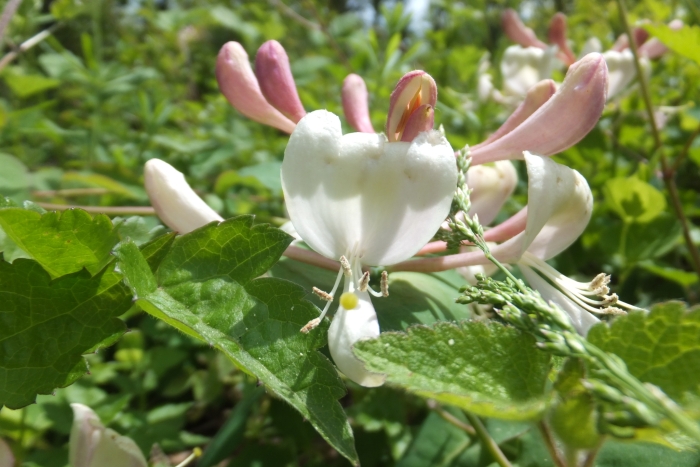Italian Woodbine
(Lonicera caprifolium)
Italian Woodbine (Lonicera caprifolium)
/
/

Emanuele Santarelli
CC BY-SA 4.0
Image By:
Emanuele Santarelli
Recorded By:
Copyright:
CC BY-SA 4.0
Copyright Notice:
Photo by: Emanuele Santarelli | License Type: CC BY-SA 4.0 | License URL: http://creativecommons.org/licenses/by-sa/4.0/ | Rights Holder: Emanuele Santarelli | Publisher: iNaturalist | Date Created: 2018-05-27T14:05:01-07:00 |























Estimated Native Range
Summary
Lonicera caprifolium, commonly known as Italian Woodbine or Perfoliate Honeysuckle, is a deciduous vine native to Central and Southern Europe, extending into Western Asia. It has naturalized in parts of southeastern Britain and northeastern North America. This climber can reach lengths of up to 20 feet (6 meters), with a twining growth habit that makes it suitable for trellises and fences. The plant features oval, blue-green leaves and highly fragrant, creamy white to yellow flowers that bloom in late spring to early summer, followed by red berries. The flowers are particularly showy and attract pollinators such as bees and hummingbirds.
Italian Woodbine is valued for its sweetly scented flowers and rapid growth, making it a popular choice for covering structures or creating living screens. It thrives in full sun to partial shade and prefers moist, well-drained soils. While it is drought-tolerant once established, regular watering during dry periods will promote optimal growth. It is used in urban planting, border planting, and as a fragrant addition to wildlife gardens. However, gardeners should be cautious as it can become invasive, spreading through both root suckers and seed dispersal. To prevent unwanted spread, it’s advisable to plant it in areas where it can be controlled or to choose non-invasive alternatives for similar uses.CC BY-SA 4.0
Italian Woodbine is valued for its sweetly scented flowers and rapid growth, making it a popular choice for covering structures or creating living screens. It thrives in full sun to partial shade and prefers moist, well-drained soils. While it is drought-tolerant once established, regular watering during dry periods will promote optimal growth. It is used in urban planting, border planting, and as a fragrant addition to wildlife gardens. However, gardeners should be cautious as it can become invasive, spreading through both root suckers and seed dispersal. To prevent unwanted spread, it’s advisable to plant it in areas where it can be controlled or to choose non-invasive alternatives for similar uses.CC BY-SA 4.0
Plant Description
- Plant Type: Shrub, Vine
- Height: 1-20 feet
- Width: 1-20 feet
- Growth Rate: Moderate
- Flower Color: Cream, Pink, White, Yellow
- Flowering Season: Spring, Summer
- Leaf Retention: Deciduous
Growth Requirements
- Sun: Full Sun, Part Shade
- Water: Low, Medium
- Drainage: Fast, Medium, Slow
Common Uses
Bee Garden, Bird Garden, Butterfly Garden, Fragrant, Groundcover, Low Maintenance, Showy Flowers
Natural Habitat
Native to Central and Southern Europe, extending into Western Asia
Other Names
Common Names: Italian Honeysuckle, Goat-leaf Honeysuckle, Italian Woodbine, Perfoliate Honeysuckle
Scientific Names: , Lonicera caprifolium, Caprifolium atropurpureum, Caprifolium germanicum, Caprifolium hortense, Caprifolium italicum, Caprifolium italicum, Caprifolium italicum var. album, Caprifolium magnevilleae, Caprifolium magnevilleae
GBIF Accepted Name: